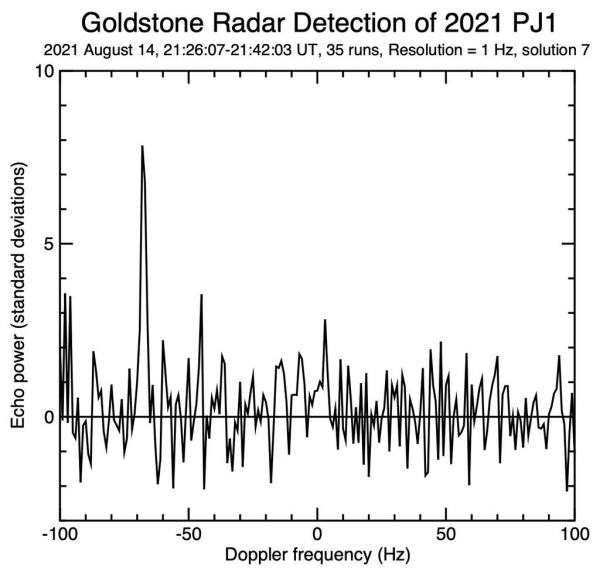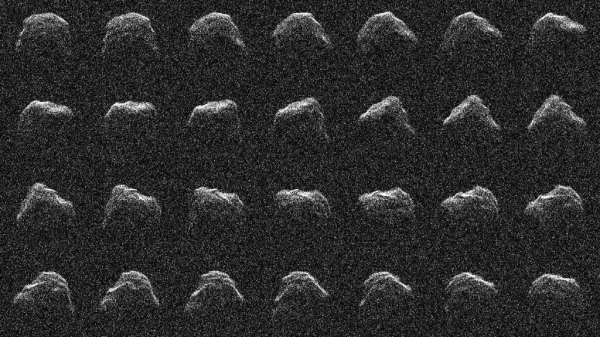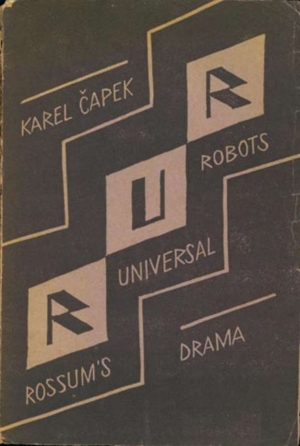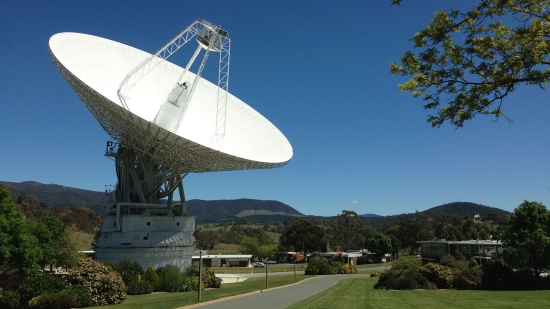by Paul Gilster | Sep 9, 2021 | Asteroid and Comet Deflection |
A century ago, when American magazine science fiction was developing, the Solar System seemed a relatively tidy place. At least, it did in comparison to today. The first issue of Hugo Gernsback’s Amazing Stories serialized a reprint of Jules Verne’s 1877 novel Off on a Comet and, indeed, in those days comets were the objects most likely to move around the system. The asteroids seemed distant in their belt and in stable orbits and there was little else between the planets. There was no Pluto.
Today, of course, we seem to have debris everywhere. The main belt asteroids are joined by trojan objects like the large population around Jupiter, and there is another belt of ancient material out beyond Neptune, the Kuiper Belt. In Earth’s neighborhood, interesting objects like 2021 PJ1, whose approach to our planet occurred on August 14 at 1.7 million kilometers, remind us that there is a large population of asteroids that move in orbits well inside the main belt, and could conceivably present a danger to us, at least enough of one to demand that we keep a close eye on their trajectories.
2021 PJ1 has a certain claim to fame, being the 1,000th near-Earth asteroid to be observed by planetary radar in the past 50 years. In this technique, we bounce a radar signal off an object and examine the photonic echo. The first asteroid to be viewed in this way was 1566 Icarus, all the way back in 1968, ‘painted’ by Goldstone radar, the same facility near Barstow, California that produced the PJ1 data this summer.

Image: The 70-meter Deep Space Station 14 (DSS-14) antenna at the Deep Space Network’s Goldstone Deep Space Complex near Barstow, California, was able to measure the Doppler frequency of the radio waves that reflected off asteroid 2021 PJ1’s surface. The figure shows radar echo signal strength on the vertical axis versus Doppler frequency (in units of hertz, or Hz) on the horizontal axis. The strong spike at a value of minus 70 Hz is the reflected signal (or “echo”) from 2021 PJ1; the other, smaller spikes are receiver noise. Credit: NASA/JPL-Caltech.
I always think primarily of Arecibo when planetary radar comes to mind, and in fact its radar capabilities were a prime reason for fighting to sustain its funding before its collapse in 2020. Well over half of existing NEO radar observations were made by its 305-meter dish. But the tally of the Goldstone Deep Space Complex is impressive via its DSS-14 70-meter and 34-meter DSS-13 antennae, with 374 near-Earth asteroids to date. Moreover, the Deep Space Network’s Canberra site, working with Australian observatories including Parkes, has notched up another fourteen.
NEA 1,001 came only a week after 2021 PJ1, an object labeled 2016 AJ193 that moved by at about 3.4 million kilometers. While 2021 PJ1 was small — between 20 and 30 meters wide — 2016 AJ193, although more distant, was a much easier catch because it’s some 40 times larger, with a diameter in the range of 1.3 kilometers. Originally observed by the NEOWISE mission, this asteroid gave us a lot more than plots on a graph: Ridges, hills, concavities and possible boulders appeared in the Goldstone observations, which also determined that it rotates with a period of 3.5 hours.

Image: This animation shows asteroid 2016 AJ193 rotating as it was observed by Goldstone’s 70-meter antenna on Aug. 22, 2021. 1.3-kilometers wide, the object was the 1,001st near-Earth asteroid to be measured by planetary radar since 1968. Credit: NASA/JPL-Caltech.
The 2016 AJ193 observations were led by Shantanu Naidu (JPL), who says:
“The 2016 AJ193 approach provided an important opportunity to study the object’s properties and improve our understanding of its future motion around the Sun. It has a cometary orbit, which suggests that it may be an inactive comet. But we knew little about it before this pass, other than its size and how much sunlight its surface reflects, so we planned this observing campaign years ago.”
The significance of planetary radar for simple security is obvious. Including telescopes on the ground and in space, we’re tracking close to 27,000 near-Earth objects, characterizing them through observations like the recent Goldstone work. The more we learn about the size, shape and composition of NEOs, the better we’ll be able to resolve questions about their trajectories and any future danger they might pose. This, in company with data from asteroid missions like Hayabusa2 and OSIRIS-REx, will help us tune our threat mitigation strategies if we ever do have to nudge an NEO.

Image: This series of images captured on Aug. 22, 2021, shows asteroid 2016 AJ193 rotate as it was observed by Goldstone’s 70-meter antenna. Credit: NASA/JPL-Caltech.

by Paul Gilster | Sep 7, 2021 | Culture and Society |
Writing about Karel ?apek, as Milan ?irkovi? did in our last entry, spurs me to note that the BBC has an interesting piece out on ?apek called The 100-year-old fiction that predicted today. It’s a fine essay delivered by Dorian Lynskey on both ?apek and the Russian writer Yevgeny Zamyatin, whose influential novel We shared a birth year of 1921 with ?apek’s R.U.R. If ?apek gave us robots, it could be said that Zamyatin gave us the modern dystopia. “If you have had any experience with science fiction,” writes Lynskey, “you will probably have imbibed some trace elements of RUR and We.”

I will defer on Zamyatin, for I suspect that Dr. ?irkovi? has thoughts about him that will appear in a future essay here. However, looking toward the origins of ideas has me thinking about another literary figure, the American writer and critic Edgar Allan Poe. Always known for his tales of the macabre, Poe (1809-1848) more or less invented the detective story, but he was also influential in the origins of what would become science fiction. Beyond that, however, his thinking about cosmology was oddly prescient, and offers a 19th Century take on what would come to be called the Big Bang.
Olber’s paradox seems to have been what jogged his thinking on the matter. A German astronomer, Heinrich Wilhelm Olbers (1758-1840) took note of an observation that had long preceded him, that an eternal infinite universe should have a bright night sky. Every line of sight should carry photons from a star if stars were randomly distributed. I learned in my research for this piece that the astronomer Thomas Digges (1546-1595), who believed in an infinite cosmos, was also puzzled by the appearance of a dark night sky, as was Johannes Kepler, who pondered how to resolve the problem in 1610.
Various explanations for the dark sky would emerge, including the idea that light could run out of energy over long enough distances (this was Digges’ thought), or that the supposed ‘ether’ in interstellar space might absorb light, but it was Poe who tackled the question is an utterly novel way in a work called Eureka: A Prose Poem (1848), originally conceived and delivered as a lecture at New York’s Society Library in February of 1848. In this earnest essay he would write that some light in the universe had simply not yet had time to reach us. He acknowledges that this wasn’t a thesis that could be proven with the science of the time, but he finds the case compelling:
Were the succession of stars endless, then the background of the sky would present us an uniform luminosity, like that displayed by the Galaxy—since there could be absolutely no point, in all that background, at which would not exist a star. The only mode, therefore, in which, under such a state of affairs, we could comprehend the voids which our telescopes find in innumerable directions, would be by supposing the distance of the invisible background so immense that no ray from it has yet been able to reach us at all. That this may be so, who shall venture to deny? I maintain, simply, that we have not even the shadow of a reason for believing that it is so.
A universe infinite in age and space would be one in which light, from no matter what distance, would have had time to reach the Earth, leading to the speculation that the universe was finite in time, an idea not highly regarded in that era. Indeed, we can take the idea of an infinite universe back to the ancient Greeks, and it’s worth remembering, given the veneration in which he was held in Poe’s lifetime, that Isaac Newton supported a universe of infinite space and, in the thinking of many, infinite time, one that Olbers’ paradox seemed to challenge. In this sense, Poe is strikingly modern.
Poe’s is a universe that was not always there, and moreover, one that is growing. For even more modern, given that we are decades before Hubble’s discovery of galactic red shift, Einstein’s flirtation with and final rejection of a ‘cosmological constant,’ and Georges Lemaître’s conception of an expanding universe, is Poe’s notion of what he called a ‘primordial particle.’ It’s a bit reminiscent of Lemaître’s ‘cosmic egg,’ though of course without any data to back it up. Here is another quote from Eureka:
We now proceed to the ultimate purpose for which we are to suppose the Particle created—that is to say, the ultimate purpose so far as our considerations yet enable us to see it—the constitution of the Universe from it, the Particle.
And a bit later:
The assumption of absolute Unity in the primordial Particle includes that of infinite divisibility. Let us conceive the Particle, then, to be only not totally exhausted by diffusion into Space. From the one Particle, as a centre, let us suppose to be irradiated spherically—in all directions—to immeasurable but still to definite distances in the previously vacant space—a certain inexpressibly great yet limited number of unimaginably yet not infinitely minute atoms.
Lemaître referred to his own “hypothesis of the primeval atom,” as does Poe. In the latter, we have origin in a particle that can, by infinite divisibility, diffuse itself into space. Poe, of course, had no notion of ‘spacetime,’ as it would later be known thanks to the work of the mathematician Hermann Minkowski, who united space and time in a four-dimensional space-time in a famous 1908 paper. It was this idea of a spherically growing universe, however, that gave Poe his intuition about Olbers’ paradox.
He takes it a good bit further. Poe’s unitary particle exploded to fill the universe with diffuse matter. Gathering into clouds, this matter condensed to become stars and planets. As Poe saw it, gravity would wrestle with a principle of vitality and thought that, confusingly enough, he called electricity, which created life. But the universe’s end was clear: Gravity would pull it back together into a new primordial particle.
For a good deal more on Poe’s role in 19th Century thinking, John Tresch’s book The Reason for the Darkness of the Night: Edgar Allan Poe and the Forging of American Science (Farrar, Straus and Giroux, 2021) is of obvious relevance to our theme. Tresch picks up on Poe’s cyclic cosmos, saying of Eureka:
Eureka was one of the most creative, audacious, and idiosyncratic syntheses of science and aesthetics in nineteenth-century America. Its capitalized phrase the “Universe of Stars” may suggest a parallel with the “United States.” The book’s effort to establish a balance between individuality and unity, between equality and difference — its declaration of interdependence — could be read as a restatement of his nation’s enduring tensions. But if this was an allegory of America, the road Poe saw ahead would oscillate between paradise and inferno while somehow keeping both in view — “an idea which the angels, or the devils, may entertain.”
Poe and Science Fiction
I mentioned above that Poe had also played around the edges of what would become science fiction. Indeed, in the first issue of Amazing Stories in 1926, editor Hugo Gernsback would describe the kind of tale to be presented therein as “the Jules Verne, H G Wells, and Edgar Allan Poe type of story.” This was by way of introducing what Gernsback called ‘scientifiction’ to a wide audience after earlier tales in his science and radio-themed magazines, and was taken as a kind of declaration. Gernsback pointed to Amazing Stories as “A New Sort of Magazine.”
There are various ways to date science fiction’s emergence, and I tend to favor Brian Aldiss’ view that it was Mary Shelley who started the ball rolling with her 1818 novel Frankenstein (and we can add her 1826 offering The Last Man as well), though SF origins take us into territory where argument is rife. Some critics cite Poe’s 1835 tale “The Unparalleled Adventure of One Hans Pfaall” as science fictional. But it was Poe’s “Mellonta Tauta” (1849) that SF writer and scholar James Gunn once declared the first modern science fiction story, though it’s a lightweight piece of work.
The title is Greek for something like “things of the future” and the tale describes the world of 2848 as seen through the eyes of a narrator named Pundita, who travels aboard an exotic airship. The story is chaotic and hops about between what are meant to be diary entries, casting an eye back on the era in which Poe wrote, as well as other episodes in human history. Much 19th Century knowledge has been lost, so that the narrator puzzles over things that are obvious and wields a satirical blade in examining current follies.
Here too we have a bit of astronomy, no particular surprise. In “Hans Pfaall” he had drawn heavily on John Herschel’s 1833 Treatise on Astronomy. As a boy he already had a telescope and is said to have excelled in the subject at Richmond Academy. An entry in the journal that frames “Mellonta Tauta” describes stellar motion:
Last night had a fine view of Alpha Lyræ, whose disk, through our captain’s spy-glass, subtends an angle of half a degree, looking very much as our sun does to the naked eye on a misty day. Alpha Lyræ, although so very much larger than our sun, by the by, resembles him closely as regards its spots, its atmosphere, and in many other particulars. It is only within the last century, Pundit tells me, that the binary relation existing between these two orbs began even to be suspected. The evident motion of our system in the heavens was (strange to say!) referred to an orbit about a prodigious star in the centre of the galaxy. About this star, or at all events about a centre of gravity common to all the globes of the Milky Way and supposed to be near Alcyone in the Pleiades, every one of these globes was declared to be revolving, our own performing the circuit in a period of 117,000,000 of years!
And so on. There is satire within, and perhaps a swipe at the emerging ideas of Marx and Engels, for Pundita describes a society without individualism and laces her tale with skepticism about 19th Century science even as she describes future technologies. Poe’s interest in cosmology is obviously more clearly stated in Eureka, but “Mellonta Tauta” is an interesting curiosity. First published in Godey’s Lady’s Book in February 1849, it rather fascinatingly tells of the discovery of a stone monument to George Wsahington from the 1900s and amusingly interprets it through the eyes of the future in ways science fiction writers have exploited ever since.

Image: A bound volume containing six issues of Godey’s Lady’s Book, including the February 1849 issue that featured the first printing of Poe’s “Mellonta Tauta.” Credit: Worthpoint.
So Poe has to be added into the cabinet of historical curiosities regarding the emergence of both science fiction and modern conceptions of cosmology. There is a wonderful analysis of Poe’s science fictional elements in the online Science Fiction Encyclopedia that examines quite a few Poe stories in this light. In the 101st issue of the Australian science fiction fanzine SF Commentary, edited by Bruce Gillespie, Russell Blackford makes an interesting point about where the story’s true influence may lie in an essay called “Science Fiction as a Lens into the Future”:
The story… sheds doubt on historians’ confident interpretations of the practices of other peoples living in earlier times. It is full of jokes, many of which are puzzling for today’s readers, and even when they’re explained it is often difficult to be sure exactly what ideas Poe is putting forward and which he is satirising. (Other material that Poe wrote about the same time suffers from the same problems of interpretation.) Nonetheless, Poe laid a foundation for the development of satirical science fiction set in future, greatly altered societies.
Blackford’s essay is a gem, as are many things in the long-lived SF Commentary, whose editor is, thankfully, still active and apparently inexhaustible. Issue No. 1, after all, goes back to 1969, and is also available online, along with the complete corpus in between. I wouldn’t miss an issue.

by Paul Gilster | Sep 3, 2021 | Culture and Society |
If biological life gives way to its own creations, should we adjust our SETI outlook to include entire civilizations composed of artificial intelligences? A postbiological culture was certainly on the mind of the Czech writer Karel ?apek (1890-1938), whose work is the subject of today’s essay by Milan ?irkovi?. It’s a good time to reassess this author as we careen toward what may or may not be a ‘singularity,’ when digital intelligence eclipses our own. As ?irkovi? explains, ?apek was an utterly indefatigable writer whose work is less well known in the west than it should be given its significance not only to science fiction but the study of the future. Dr. ?irkovi? is a research professor at the Astronomical Observatory of Belgrade, the author of numerous research and professional papers as well as three research monographs and four books, the most recent of which is The Great Silence: The Science and Philosophy of Fermi’s Paradox (Oxford University Press). Read on to learn about the life and work of a key figure in our conception of the human, and post-human, future.
by Milan ?irkovi?

This year marks a century since the world premiere of Karel ?apek’s drama R.U.R. in the town of Hradec Králové in the Czech Republic. By that very fact, it marks a century of the word “robot” which has spread into all world languages from the very title of ?apek’s drama, since the latter is an initialism standing for Rossumovi Univerzální Roboti in the Czech original (meaning Rossum’s Universal Robots). It is the name of the megacorporation responsible for introduction of robots as a cheap and versatile workforce, and – no big spoiler there, considering how famous and even canonical the drama has become – ultimately responsible for the extinction of the human species.
According to an interview given to a Czech newspaper more than a decade later, the true creator of the word was Karel’s brother, Josef, a talented painter and poet. While Karel could not decide what to call artificial people, Josef (who lived with him at the time) suggested the work “robot” coming from robota, meaning hard work, usually done involuntary in serfdom. A similar word, denoting labour or hard work, is present in all Slavic languages (e.g., “??????” in Ukrainian, “rabota” in Serbian and Croatian, etc.). Formally, of course, one could argue that the word was coined in 1920, when the drama was written, and Karel’s conversation with Josef took place, but the neologism began to spread only after the premiere in 1921.

R.U.R. is arguably still the most important and the best written science fiction play ever. It is far from being ?apek’s only claim to fame, however. On the contrary, he was extremely, unbelievably, fantastically prolific for a man of lifelong poor health who died at 48. He wrote a dozen novels, hundreds of short stories in all genres, a book on gardening, 5 books of letters describing various travels all over Europe, children books, literally thousands of newspaper articles, essays, vignettes, and Borges-like “apocrypha”. His novels, both realistic (Hordubal, Meteor, Ordinary Life, Life and Work of the Composer Foltýn) and SF (Krakatit, The Absolute at Large, and his most significant work, War with the Newts) are all very complex affairs, full of difficult philosophical and psychological ideas, but also mostly ironic and often spiced with Monty-Pythonesque black humor.
His work was extraordinary popular all across Europe between the world wars, especially among people of the Enlightenment tradition, frightened by the rise of mass-murdering totalitarianism in Italy, Germany, and the Soviet Union. He was repeatedly nominated for the Nobel Prize in literature, but according to the since uncovered documents, his fierce anti-totalitarian stance made him a politically undesirable laureate for the (always politically shy) Swedish academy. A self-identified radical centrist, ?apek viscerally hated nationalism and nationalism-inspired tyrranies, such as those of Mussolini and Hitler, and he openly mocked the latter’s pretensions in War with the Newts; he also deeply despised communism and called it the surest road to total economic and cultural impoverishment.
The Munich Agreement, signed on September 30, 1938, effectively enabled the destruction of Czechoslovakia by the Nazis, first by cessation of the so-called Sudetenland, and subsequently by occupation of the rest of the country by March 15, 1939. The occupation was followed by immediate imposition of all the measures of totalitarian terror, destruction of Czech institutions and culture, bloody purges, arrests, deportations, etc. ?apek was perhaps fortunate not to be able to see such a horrible denouement; he died on December 25, 1938, apparently a consequence of a sudden heart attack while working in his garden. By a dark irony worthy of Kafka, or indeed ?apek himself, the Nazi occupiers ordered his arrest and transfer to a concentration camp a few months later, while unaware (“an administrative error”) that he was already deceased. Josef ?apek was arrested and later murdered in the infamous Bergen-Belsen concentration camp.
To return to R.U.R., there is some debate on the proper conceptualization of ?apek’s robots. The author himself contributed to this, since he maintained a kind of delightful ambiguity between the “natural” and the “artificial”, which was a kind of philosophical point with him. In a subsequent letter, whose English translation was published in Science Fiction Studies, he insisted on biological substrate as the basis of his androids, imagined as “biological machines”, rather than the metallic creations we continue to associate with the concept of a machine.
In the final analysis, the nature of the substratum is irrelevant: even if we did not know it in the 1920s, we are confident now that life is just biochemical machinery of high complexity. Just a couple of years after ?apek’s drama had its world premiere, the first serious hypotheses about the origin of life in a completely naturalistic manner were put forward by Alexander I. Oparin and John B. S. Haldane. They were considered speculative (if not, ironically, more science fiction than science) until, a few decades later, when an ambitious graduate student named Stanley Miller and his mentor Harold Urey performed what was perhaps the most spectacular and most important experiment of the 20th century. In the analog simulation of Earth’s early, reducing atmosphere, Miller and Urey achieved synthesis of many organic compounds, including vital amino acids (and many more were discovered decades later in the original samples by Miller’s student Jeffrey Bada). This and many subsequent developments in the abiogenesis studies showed how easy abiogenesis probably is in the realistic situations where many millions of years and huge spatial volumes/surface areas are available. Therefore, even the “rare Earth” theorists have consistently argued that simple life is probably ubiquitous throughout the universe. And from the information view of life, the substrate is positively irrelevant.
Obviously, the heritage of R.U.R. is not all roses – after all, bots of internet infamy are just a shortening of robots. And while the robot rebellion is unlikely to take such a melodramatic form as in ?apek’s drama, the threat of making humans irrelevant in the work market or even entirely superfluous looms large. Ultimately, all worries about the AI risk, as elaborated in such a brilliant book as Nick Bostrom’s Superintelligence, follow from the apocalyptic vision of R.U.R. and its prototypical Robot Rebelion.

The drama is highly relevant today for some additional reasons, however, notably for study of the future as well as the astrobiology/SETI field. It offers a first glimpse of postbiological evolution, which is likely to be the dominant form of evolution in the universe in the fullness of time, as suggested, since about the turn of the century, by diverse authors such as Steven J. Dick, John Smart, Juan Chela-Flores, Anders Sandberg, Abraham Loeb, Joseph Voros, and others. Until we accept the (transhumanist?) premise that the design space of postbiological evolution is much larger still than the design space of the good ol’ biological one, our way of conceptualizing searches for bio- and especially technosignatures will be seriously limited.
Image: A first edition of the play, with cover designed by Josef ?apek. Aventinum, Prague, 1920. Credit: Wikimedia Commons.
Perhaps the most valuable legacy of R.U.R. is, in fact, its thought-provoking ethical ambiguity, which clearly follows from ?apek’s wedding of a deeply understood evolutionary perspective with his unquenchable humanism. Superficially, it’s an unsolvable dilemma: if one understands evolution, one has to admit that humans and all their creations are emergent, but ephemeral, accidents. Humans are mammals; all mammal species last a couple of million years before going extinct. On the opposite side, humanism tells us that our creations and values carry a spark of persistence, if not true immortality.
A solution, as ?apek powerfully intuited, is a kind of postbiological evolution. If present-day humans become obsolete, the process undoubtedly quickened by our many flaws, this need not mean that our creations cannot and indeed ought not succeed us. Technically speaking, ?apek’s robots commit the ultimate genocide – and yet, strangely enough, we do not feel offended or enraged by such a turn of events (neither does the last surviving human protagonist of the drama, who helps the robots with procreation). Something new and wonderful is happening in the universe.

by Paul Gilster | Sep 2, 2021 | Communications and Navigation |
Recent updates to the Deep Space Network have me thinking about the data capabilities of laser communications, and how they will change the way missions operate. In late October, a payload called the Laser Communications Relay Demonstration (LCRD) is scheduled for launch aboard an Atlas V from Cape Canaveral. LCRD will begin its work by receiving radio frequency test signals from the mission operations center and responding with optical signals. Ultimately, the mission should be able to receive data from other missions and relay to the ground.
What we have here is NASA’s first technology demonstration of a two-way laser relay system, one that will test laser capabilities to find out, for example, about the potentially disruptive effect of clouds. Because optical signals cannot penetrate them, plans are for LCRD to transmit data from missions to separate ground stations, one in Table Mountain, California and the other at Haleakal? in Hawaii, both chosen because of their low degree of annual cloud coverage.
Also slated for late 2021 is the Terabyte Infrared Delivery (TBIRD) mission, which will demonstrate laser downlinks of 200 gigabits per second, again enlarging the agency’s capabilities at designing laser systems for small satellites.

Image: The Laser Communications Relay Demonstration payload is attached to the LCRD Support Assembly Flight (LSAF), which can be seen in this image. The LSAF serves as the backbone for the LCRD components. Attached to the LSAF are the two optical modules, which generate the infrared lasers that transmit data to and from Earth. A star tracker is also attached here. These components are visible on the left side of this image. Other LCRD components, such as the modems that encode data into laser signals, are attached to the back of the LSAF. Credit: Goddard Space Flight Center.
All of this is by way of looking at how communications are evolving, and how capacity must grow with technology, for the 39 missions the Deep Space Network regularly supports are scheduled to be joined by another 30 NASA missions in development. The network’s tracking antennas are found at Goldstone (near Barstow, CA), in Robledo de Chavela, Spain; and in Canberra, Australia. Two new antennas have added capacity, taking the DSN from 12 to 14. You can track ongoing operations on the DSN on this mesmerizing page.
You’ll recall the issues with DSS-43, the 70-meter DSN antenna at Canberra (see Voyager 2: Back in Two-Way Communication). This is the only southern hemisphere dish with a transmitter in the needed S-band frequency range and powerful enough to send commands to Voyager 2, and it took 11 months of upgrades to resolve problems with its aging equipment. Voyager 1 is able to communicate through the two northern hemisphere DSN stations, but Voyager 2’s course following the Neptune encounter in 1989 was pushed well south of the ecliptic.
JPL’s Brad Arnold is manager of the Deep Space Network:
“The refresh of DSS-43 was a huge accomplishment, and we’re on our way to take care of the next two 70-meter antennas in Goldstone and Madrid. And we’ve continued to deliver new antennas to address growing demand – all during COVID-19.”

Image: DSS43 is a 70-meter-wide (230-feet-wide) radio antenna at the Deep Space Network’s Canberra facility in Australia. It is the only antenna that can send commands to the Voyager 2 spacecraft. Credit: NASA/Canberra Deep Space Communication Complex.
The upgrades are occurring at a time when data flowing through the network has grown by a factor of 10 since the 1960s, with the prospect of much higher data volumes to come. Hence the interest in optical strategies to enable higher-bandwidth communication. Improvements in automation allow operators to oversee multiple links to spacecraft simultaneously, so the sequencing and execution of tracking passes can be fully automated. While waiting for optical methods to mature, the network is also using new protocols for the reception of multiple signals from a single antenna, splitting them in a digital receiver as a way to boost network efficiency.
When it comes to the data overload problem, laser communication is the next step, and the groundwork has continued during the past decade. In 2013, the Lunar Laser Communications Demonstration (LLCD) used a laser signal to enable fast upload and download rates (600 megabits per second) on two simultaneous high-definition video channels. LLCD was followed in 2014 by the Optical Payload for Lasercomm Science (OPALS) experiment, a demonstration onboard the International Space Station. 2017 saw the Optical Communications and Sensor Demonstration mission (OCSD), in which high-speed laser communications were demonstrated via downlink from a CubeSat to ground stations.
Meanwhile, we can look forward to the Psyche mission, scheduled for launch in 2022, in which the onboard Deep Space Optical Communications (DSOC) payload will test laser communications in a mission to an asteroid 240 million kilometers away.
We get serious advantages not just in terms of bandwidth but also in transmission and reception of signals by going this route. The diffraction rate of a radio signal is determined by the wavelength of the signal divided by the diameter of the antenna. Push into higher frequency ranges and the signal becomes narrower, offering advantages in a crowded spectrum. The DSS-43 communications with Voyager 2 make the issues stark. Because of beam diffraction, the Voyager signal now swells to over a thousand times the diameter of the Earth.
Putting this into more futuristic terms: A 20-watt laser signal beamed back to Earth from Alpha Centauri via an installation about the size of the Hubble Space Telescope would reach us. Our current capabilities extend out into the Kuiper Belt, but star-to-star is out of the question. Back in 1989, the signal we received from Voyager 2’s 23 watts was twenty billion times weaker than the power it would take to operate a digital wristwatch, yet the DSN could pluck the signal out of deep space to deliver the data. If we had a Voyager 2 entering Alpha Centauri space, its signal would be 81 million times weaker than that. Going interstellar means going to lasers.
And beyond that? Claudio Maccone has demonstrated mathematically what might be done with a communications relay at the Sun’s gravitational focus beyond 550 AU. Going more futuristic still, a network of interstellar communications could one day grow from similarly placed relays around nearby stars. The efficiencies of a network like that — if we can find a way to put one in place — are breathtaking. See The FOCAL Radio Bridge for more.
On the laser signal at Alpha Centauri, see Lesh, C. J. Ruggier, and R. J. Cesarone, “Space Communications Technologies for Interstellar Missions,” Journal of the British Interplanetary Society 49 (1996): 7–14. For more on gravitational lensing and communications, see Maccone, “Interstellar Radio Links Enhanced by Exploiting the Sun as a Gravitational Lens,” Acta Astronautica Vol. 68, Issues 1-2 (January-February 2011), pp. 76-84 (abstract/full text).

by Paul Gilster | Sep 1, 2021 | Deep Sky Astronomy & Telescopes |
The brown dwarf WISEA J153429.75-104303.3 — happily nicknamed ‘The Accident’ — is peculiar enough that it may point to a rare population of extremely old brown dwarfs. Dan Caselden, a citizen scientist who built an online program to filter data from the NEOWISE spacecraft, is able to highlight brown dwarfs moving through the NEOWISE field with his software, and while looking at one, he caught a glimpse of another. Call that a lucky catch, because the object didn’t match his program’s profile of a conventional brown dwarf.
We’ve found about 2,000 brown dwarfs thus far, many using data from WISE — Wide Field Infrared Survey Explorer — which was launched in 2009, placed into hibernation in 2011 after its primary mission ended, and then reactivated in 2013 as NEOWISE, a repurposed spacecraft given the new goal of tracking near-Earth objects. WISE 1534?1043 — the shortened name of the object, used by the authors of a new paper on it — stands out from all previously known brown dwarfs because it seems to have very little methane, unlike the brown dwarfs we’re familiar with, among which methane is common at WISE 1534?1043’s temperatures.
What we may be looking at is the signature of an extremely old, and cold, brown dwarf that emerged at a time when the galaxy was low enough in carbon that little methane could form in its atmosphere. That’s the thesis of the paper in Astrophysical Journal Letters, whose lead author is Davy Kirkpatrick (Caltech). The authors believe WISE 1534?1043 may be between 10 and 13 billion years old, making it double the median age of known brown dwarfs.
Adding punch to the hypothesis is the fact that, at about 50 light years from Earth, WISE 1534?1043 is moving much faster — well over 200 kilometers per second — than any other brown dwarf at a comparable distance. This may imply gravitational acceleration from encounters sustained in a long, long lifetime. If one such ancient brown dwarf is out there, we should find others.
Co-author Federico Marocco (Caltech) led the new observations of WISE 1534?1043, which extend earlier studies of the object, using the Keck and Hubble instruments:
“It’s not a surprise to find a brown dwarf this old, but it is a surprise to find one in our backyard. We expected that brown dwarfs this old exist, but we also expected them to be incredibly rare. The chance of finding one so close to the solar system could be a lucky coincidence, or it tells us that they’re more common than we thought.”

Image: This video shows data from NASA’s Near-Earth Object Wide-Field Infrared Survey Explorer (NEOWISE), launched in 2009 under the moniker WISE. The moving object in the bottom left corner is a brown dwarf officially named WISEA J153429.75-104303.3 and nicknamed “The Accident.” Credit: NASA/JPL-Caltech/Dan Caselden.
This unusual object is too faint at all wavelengths, the paper notes, for spectroscopy to be used at any current facility. Thus the interpretations given in the Kirkpatrick paper rely on trends found among other better known objects extended “into a terra incognita guided by theoretical predictions.” In addition to the idea that it is an extremely old brown dwarf with the low metallicity of its origins in a young galaxy, the authors examine other possibilities.
Are we actually dealing with an extremely low mass young brown dwarf? Evidently not, as the methane deficiency is hard to reconcile with this option. Could WISE 1534?1043 be an ejected exoplanet? Here we need atmospheric data, which we don’t have, to examine the elements therein, knowing that giant planets in our Solar System are more metal rich than the Sun (carbon is enhanced in Jupiter by three times the amount found in the Sun, and more so in Saturn, Uranus and Neptune). Thus we would have a marker, if we could find it. From the paper:
Under this hypothesis, WISE 1534?1043 is photometrically unusual because such elemental differences would profoundly affect its atmospheric composition and emergent spectrum. Unfortunately, forward modeling that incorporates a wide array of elemental abundance differences does not yet exist, so our best method to test this hypothesis is atmospheric retrieval, once a suitable spectrum for WISE 1534?1043 is obtained.
A final possibility is an ultracold stellar remnant, meaning a white dwarf, but this explanation falls short due to models showing a white dwarf could not have cooled to these temperatures within the lifetime of the Milky Way. Thus only one conclusion seems likely:
We conclude that the unique object WISE 1534?1043 is most likely a cold, very metal-poor brown dwarf—perhaps even the first Y-type subdwarf…
But note this:
Verification, refutation, or further befuddlement should be possible via additional photometry and broad-wavelength spectroscopy from the James Webb Space Telescope.
‘Further befuddlement’ indeed! An honest comment about an extremely unusual object.
The paper is Kirkpatrick et al., “The Enigmatic Brown Dwarf WISEA J153429.75-104303.3 (a.k.a. “The Accident”),” Astrophysical Journal Letters Vol. 915, No. 1 (30 June 2021), L6 (abstract / full text).















